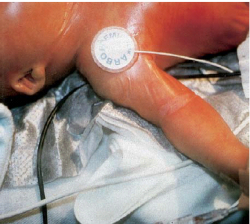Collodion baby

Collodion baby is not a distinct disease entity, but rather a transitory state at birth which can be present in various types of ichthyosis at birth. This means that when a child is born as a collodion baby the ultimate correct diagnosis still has to be established. In most cases this will turn out to be autosomal recessive congenital ichthyosis (ARCI).
At birth, the entire skin of the neonate is covered by a membrane which resembles a parchment paper or a collodion. Shortly after birth this membrane starts to crack and to peel off. This process can take up to 3 weeks. Often an everted lower eye lid (ectropion) is noted. Collodion babies are “risk neonates” requiring careful medical monitoring and should be admitted to a neonatal intensive care unit. There are manifold possible complications such as a considerable fluid loss or hypothermia which need to be checked and treated when they occur.
When a collodion baby is born it is hardly possible to tell which exact type of ichthyosis is present and how severe the disease will be eventually.
In about ten per cent of the cases collodion babies after shedding of the collodion membrane greatly improve and later on show only minimal scaling or even no scaling. Such fortunate clinical courses are nowadays referred to as “self-improving collodion ichthyosis”. An older term was “self-healing collodion baby”.
